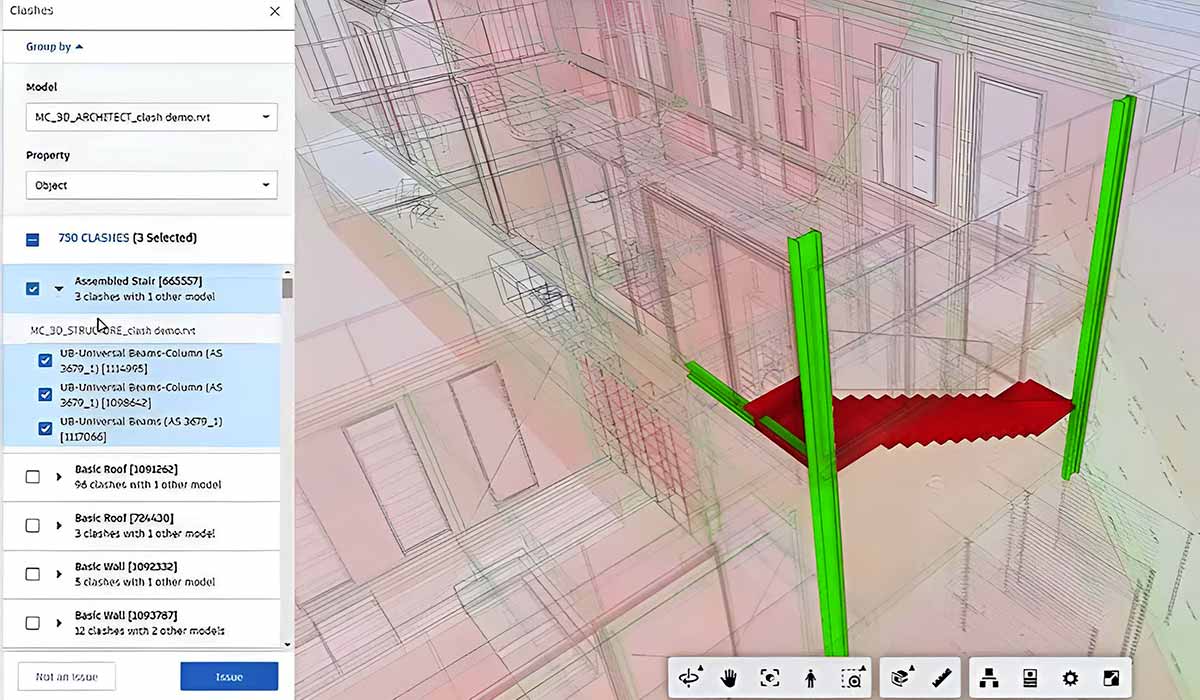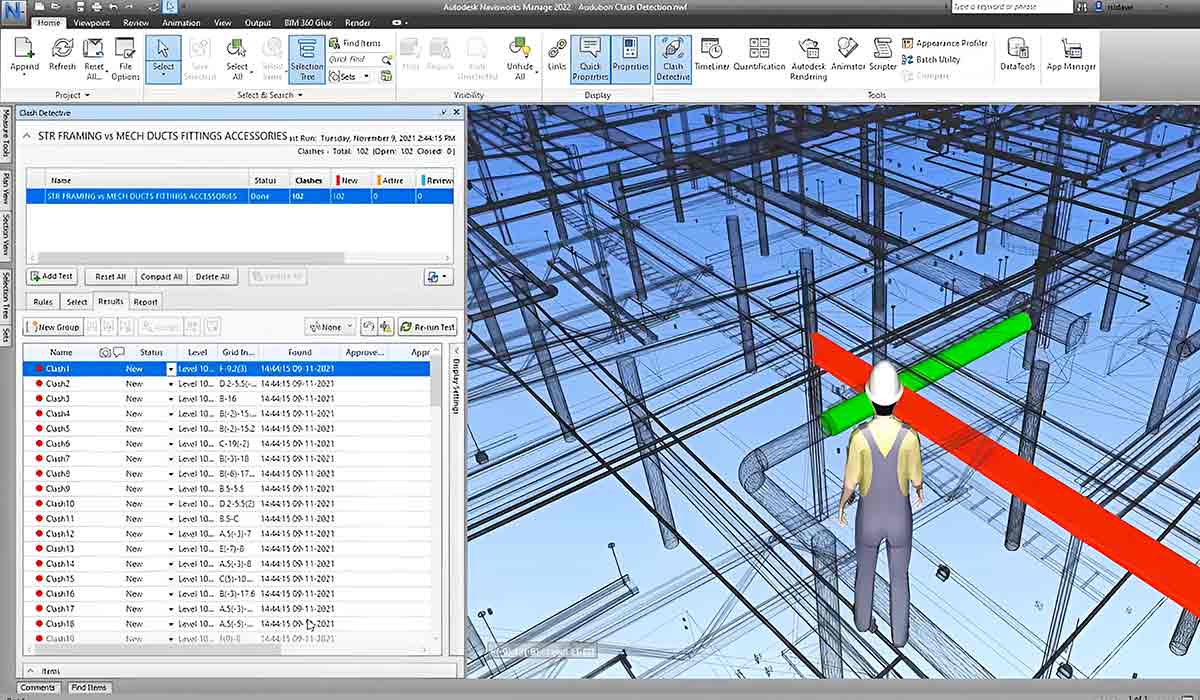Understanding what is Clash Detection in BIM Technology
Clash detection in building information modeling (BIM) is the process of identifying conflicts or clashes that occur when multiple elements in a 3D model occupy the same space. This crucial step helps in detecting potential issues before construction begins and avoid design changes.
Software for Clash detection in construction projects works by analyzing the 3D models of different disciplines, such as architecture, structure, and MEP(Mechanical, Electrical, Plumbing) systems, to identify clashes where elements intersect or conflict with one another.
Various types of clashes are commonly identified in BIM models, including hard clashes where elements physically intersect and soft clashes where elements are close but don’t physically clash. Addressing these clashes is essential to ensure the integrity and coherence of the overall design process.

What is clash detection in building information modeling?
Clash detection in Building Information Modeling (BIM) refers to the process of identifying and resolving conflicts or ‘clashes’ among the different components of a building design stages before the construction phase begins. The goal is to ensure that the various elements of the building, such as structural frames, electrical conduits, plumbing, HVAC systems, and other services, do not physically interfere with each other.
There are generally three types of clashes that can be detected through this process:
1. Hard Clash: This type of clash occurs when two solid objects occupy the same physical space, indicating a direct conflict that would prevent construction from proceeding as planned. For example, a beam running through a duct would be a hard clash.
2. Soft Clash: This involves conflicts where objects do not necessarily intersect physically but invade each other’s buffer zones, or tolerance limits. These areas are designated around components for access, maintenance, or airflow. Detecting and resolving soft clashes is essential for functionality and long-term sustainability of building systems.
3. Workflow Clash: This pertains to clashes in the construction sequence or scheduling. It involves detecting and resolving potential conflicts in the timing and location of construction activities to ensure a smooth workflow.
Clash detection is performed using specialized BIM software that can automate the detection process, highlighting the areas of conflict among the digital representations of the building components. This process allows architects, engineers, and construction professionals to identify and resolve these issues during the design phase, significantly reducing the risk of costly changes, delays, and compromises in safety and quality during construction.
Effective clash detection results in a more coordinated and efficient Process for construction, optimizing time and resources while enhancing the overall quality of the final build.
How does clash detection software work in construction projects?
Software for clash detection functions as an integrated tool within Building Information Modeling (BIM) systems to identify, inspect, and report conflicts or “clashes” between different model elements in construction projects. These sophisticated tools for clash detection comes handy to analyze 3D models created by architects, engineers, and other construction professionals, seeking out physical overlaps (hard clashes), insufficient spatial allowances (soft clashes), and scheduling conflicts (workflow clashes). By leveraging advanced algorithms, these programs can efficiently scan vast amounts of data, enabling teams to resolve potential issues before they escalate into costly onsite problems. The integration of clash detection early in the design and planning phases significantly enhances project efficiency, reduces the risk of delays, and leads to more accurate budgeting and scheduling.
Types of clashes commonly identified in BIM models
The three primary clash types detected through BIM are hard, soft, and workflow clashes. Hard clashes occur when two physical components occupy the same space, indicating a direct conflict that requires immediate resolution. Soft clashes identify spatial or clearance conflicts, where elements may not physically intersect but fail to meet predefined spacing requirements, potentially affecting maintenance and operational efficiency. Workflow clashes arise when the sequencing of construction tasks leads to logistical conflicts, such as access issues or installation order problems, impacting project timelines and work efficiency.
Benefits of BIM Clash Detection
Clash detection contributes to efficient Process for constructions by enabling early identification and resolution of clashes, reducing conflicts and rework during the construction phase. This proactive approach enhances project coordination and collaboration among different teams.
Utilizing BIM clash detection for project management enhances decision-making processes, minimizes errors, and improves project outcomes. It streamlines workflows, reduces project delays, and enhances the overall construction quality.
Clash detection tools play a vital role in preventing project delays by providing real-time report for clashes, enabling prompt resolution of conflicts, and ensuring smooth project progress without interruptions.
How does clash detection contribute to efficient construction processes?
Efficient Process for constructions are heavily dependent on the early identification and resolution of design and planning conflicts. Clash detection facilitates this by providing a proactive approach to conflict resolution, allowing project teams to make informed decisions early in the project lifecycle. This early detection minimizes rework, reduces material wastage, and ensures that project timelines are adhered to, ultimately contributing to significant cost savings and efficiency improvements.
Benefits of clash detection for project management
Incorporating BIM clash detection into project management practices offers numerous benefits, including enhanced collaboration among stakeholders, improved risk management, and increased project transparency. It enables project managers to maintain tighter control over schedules and budgets by preemptively identifying issues that could lead to delays or cost overruns. Furthermore, clash detection facilitates better communication within the project team, ensuring that everyone is aware of potential problems and their solutions, fostering a collaborative environment for project execution.
Clash detection tools and their role in preventing project delays
Clash detection tools play a pivotal role in preventing project delays by automating the process of identifying conflicts between various components of a construction project. These tools, integrated with BIM software, allow for real-time clash detection and resolution, enabling project teams to address issues promptly. By ensuring that all elements of the project are correctly aligned and fit for purpose before construction begins, these tools significantly reduce the likelihood of delays caused by onsite rework and modifications.
Process of BIM Clash Detection
The clash detection process in BIM involves a step-by-step approach, starting with the identification of clash types, followed by analyzing report for clashess, and finally resolving clashes through collaboration and coordination among project teams.
Utilizing BIM integration tools enhances the effectiveness of clash detection and resolution by enabling seamless communication, data exchange, and streamlined workflows between different disciplines involved in the project.
Step-by-step guide to the clash detection process in BIM
The clash detection process typically involves several key steps, starting with the creation of a detailed 3D model of the construction project. This model is then analyzed using Software for clash detection, which scans for and identifies any conflicts. Detected clashes are categorized (as hard, soft, or workflow clashes) and documented, with reports generated for review by the project team. These reports guide discussions and collaborative problem-solving efforts to resolve identified issues. The process is iterative, with the model and clash reports updated as solutions are implemented and as the project evolves.
- Model Preparation: Begin with the creation of detailed 3D BIM models by architects, engineers, and other stakeholders to represent all project aspects.
- Integration of Models: Integrate these individual models into a unified BIM model to facilitate a comprehensive clash detection analysis.
- Clash Detection Analysis: Employ specialized software for BIM, such as Autodesk Navisworks, to automatically scan the integrated model for clashes, including hard, soft, and workflow conflicts.
- Classification and Prioritization: Classify and prioritize detected clashes to address the most critical issues promptly, preventing project delays.
- Resolution Meetings: Conduct meetings with all project stakeholders to discuss and agree on solutions for the identified clashes.
- Revision and Reanalysis: Update the BIM model based on agreed solutions and reanalyze to ensure all clashes have been resolved.
- Documentation and Reporting: Maintain detailed reports of clashes, resolutions, and meeting outcomes for accountability and progress tracking.
- Final Validation: Perform a final validation of the model to ensure it is free from major conflicts and ready for construction.
- Implementation and Monitoring: As construction proceeds, continuously monitor and update the model to keep the project clash-free until completion.
Utilizing BIM integration tools for effective clash detection and resolution
Effective clash detection and resolution are facilitated by the integration of BIM tools that support seamless collaboration and data sharing among project stakeholders. These tools allow for the continuous updating and management of 3D models, ensuring that all team members have access to the most current information. Integration tools also support the aggregation of models from different disciplines, providing a comprehensive view of the project that is crucial for effective clash detection.
Best Practices for Effective Clash Detection
Implementing clash detection at different stages of the design and construction process is crucial to identifying and resolving clashes early, minimizing rework, and ensuring project efficiency. Early collaboration among disciplines fosters a proactive approach to clash detection and resolution.
Project team collaboration plays a significant role in successful clash detection and resolution by promoting clear communication, sharing reports for clashess, and fostering a collaborative work environment that prioritizes conflict resolution and project success.
Utilizing Software for clash detection tools like Navisworks enhances the accuracy and efficiency of clash detection processes, providing detailed insights, visualization tools, and comprehensive reports for effective clash resolution.
Implementing clash detection at different stages of the design and construction process
Best practices for clash detection involve its implementation at various stages throughout the project lifecycle, from preliminary design to detailed construction planning. Early implementation allows for the identification of potential issues before they become embedded in the project plans, making them easier and less costly to resolve. Regular clash detection checks should be scheduled at key project milestones to ensure that new conflicts are identified and addressed promptly.
Role of project team collaboration in successful clash detection and resolution
Successful clash detection and resolution are highly dependent on effective collaboration among all project stakeholders. This collaboration is facilitated by sharing clash detection reports and engaging in regular coordination meetings to discuss and resolve identified issues. Open communication and a willingness to work together towards common goals are essential for leveraging the full benefits of clash detection.
Utilizing clash detection with software tools like Navisworks for accurate results
Software tools like Autodesk Navisworks are integral to achieving accurate and efficient clash detection. These tools offer advanced features for clash analysis, reporting, and visualization, enabling project teams to understand and address conflicts effectively. By leveraging such software, teams can ensure that clash detection is both thorough and accurate, leading to higher-quality project outcomes.
Early Collaboration Among Disciplines
Early and ongoing collaboration among different disciplines, including architecture, engineering, and construction, is crucial for identifying and resolving clashes at an early stage. This interdisciplinary approach ensures that all aspects of the project are considered in clash detection efforts, leading to more comprehensive and effective resolutions.
Clear Communication of Clash Reports
The clear communication of clash detection reports is essential for ensuring that all team members understand the issues at hand and the proposed solutions. Reports should be detailed yet accessible, with visual aids where possible, to facilitate understanding and action across disciplines.
Continuous Monitoring and Updating of Models
Continuous monitoring and updating of BIM models are key to effective clash detection and resolution. As the project progresses and changes are made, models should be regularly reviewed and updated to reflect the current state of the project. This ensures that clash detection efforts are based on the most accurate and up-to-date information.
Common Clash Detection Challenges
Coordination Issues :
Coordination issues among different project teams and disciplines can hinder effective clash detection. These issues often stem from miscommunication, conflicting schedules, and differing priorities. Overcoming these challenges requires a commitment to collaboration and open communication from all stakeholders.
Model Inconsistencies
Model inconsistencies, such as discrepancies in the level of detail or inaccuracies in the representation of physical elements, can complicate clash detection efforts. Ensuring that all models are created and maintained according to consistent standards is crucial for effective clash detection.
Integration Problems
Integration problems with BIM software and tools can also pose challenges to clash detection. These may include compatibility issues, data loss during import/export, and difficulties in aggregating models from different sources. Addressing these challenges often involves investing in interoperable software solutions and establishing clear protocols for data management.
Technologies Used for Clash Detection
Rule-based Clash Detection
Rule-based clash detection involves the use of predefined rules and criteria to identify conflicts within BIM models. This approach allows for the automated detection of clashes that violate specific design, spacing, or sequencing requirements, providing a systematic way to identify potential issues.
Model-based Clash Detection
Model-based clash detection relies on the direct analysis of 3D models to identify physical conflicts between elements. This approach provides a detailed and intuitive way to visualize clashes, making it easier for project teams to understand and address conflicts.
Automated Clash Detection
Automated clash detection utilizes advanced algorithms and machine learning techniques to automatically identify and categorize clashes in BIM models. This approach significantly increases the efficiency and accuracy of clash detection, enabling the rapid identification of potential issues.
Clash Detection Software Tools
Autodesk Navisworks
Autodesk Navisworks is a leading software tool for BIM clash detection, offering comprehensive features for clash analysis, visualization, and reporting. It supports the integration of models from multiple disciplines, making it an essential tool for collaborative project management. Get your free trail on official website here
Solibri Model Checker
Solibri Model Checker is a powerful tool for BIM quality assurance and quality control, including advanced capabilities for clash detection. It allows users to define custom rules for clash detection, ensuring that analyses are tailored to specific project requirements. Official Website
Tekla BIMsight
Tekla BIMsight is a free BIM collaboration tool that offers functionalities for model viewing and clash detection. It facilitates easy sharing and communication among project stakeholders, making it a valuable tool for team collaboration and coordination. Official Website
Conclusion
In conclusion, the 2024 guide to Building Information Modeling (BIM) clash detection is a crucial resource for construction professionals seeking to enhance project efficiency and reduce costs. Emphasizing the integration of cutting-edge software like Autodesk Navisworks and the importance of early-stage collaboration, this guide provides a comprehensive overview of the strategies for identifying and resolving design and construction clashes. By focusing on proactive clash detection and leveraging the latest in technology, teams can navigate the complexities of modern construction projects with greater ease, ensuring that projects not only meet their deadlines but also exceed quality standards. This commitment to innovation and best practices in clash detection is what sets the foundation for achieving excellence in the rapidly evolving construction industry, making it an essential read for those aiming to stay at the forefront of their field.



